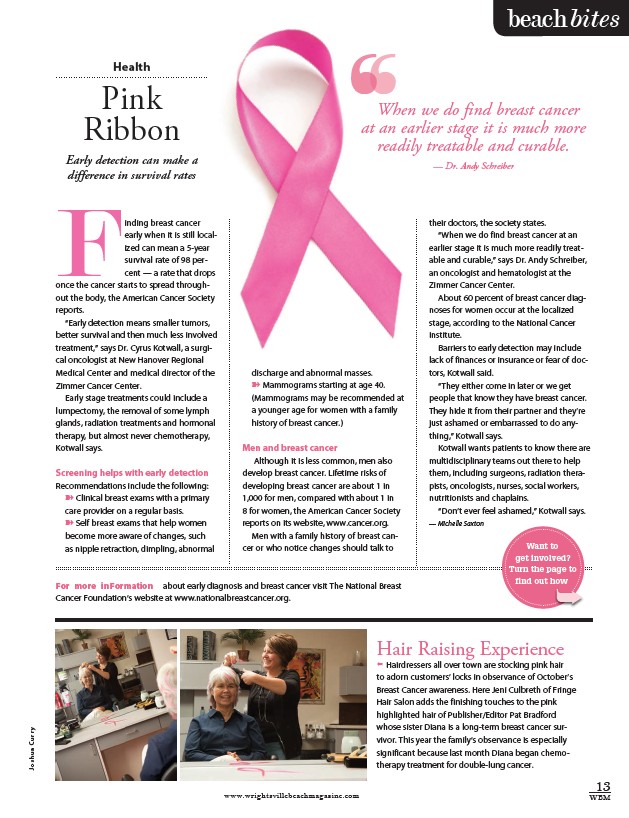
beach bites
13
— Dr. Andy Schreiber ‘‘
When we do find breast cancer
at an earlier stage it is much more
readily treatable and curable.
www.wrightsvillebeachmagazine.com WBM
Health
Pink
Ribbon
Early detection can make a
difference in survival rates
Finding breast cancer
early when it is still localized
can mean a 5-year
survival rate of 98 percent
— a rate that drops
once the cancer starts to spread throughout
the body, the American Cancer Society
reports.
“Early detection means smaller tumors,
better survival and then much less involved
treatment,” says Dr. Cyrus Kotwall, a surgical
oncologist at New Hanover Regional
Medical Center and medical director of the
Zimmer Cancer Center.
Early stage treatments could include a
lumpectomy, the removal of some lymph
glands, radiation treatments and hormonal
therapy, but almost never chemotherapy,
Kotwall says.
Screening helps with early detection
Recommendations include the following:
Clinical breast exams with a primary
care provider on a regular basis.
Self breast exams that help women
become more aware of changes, such
as nipple retraction, dimpling, abnormal
discharge and abnormal masses.
Mammograms starting at age 40.
(Mammograms may be recommended at
a younger age for women with a family
history of breast cancer.)
Men and breast cancer
Although it is less common, men also
develop breast cancer. Lifetime risks of
developing breast cancer are about 1 in
1,000 for men, compared with about 1 in
8 for women, the American Cancer Society
reports on its website, www.cancer.org.
Men with a family history of breast cancer
or who notice changes should talk to
their doctors, the society states.
“When we do find breast cancer at an
earlier stage it is much more readily treatable
and curable,” says Dr. Andy Schreiber,
an oncologist and hematologist at the
Zimmer Cancer Center.
About 60 percent of breast cancer diagnoses
for women occur at the localized
stage, according to the National Cancer
Institute.
Barriers to early detection may include
lack of finances or insurance or fear of doctors,
Kotwall said.
“They either come in later or we get
people that know they have breast cancer.
They hide it from their partner and they’re
just ashamed or embarrassed to do anything,”
Kotwall says.
Kotwall wants patients to know there are
multidisciplinary teams out there to help
them, including surgeons, radiation therapists,
oncologists, nurses, social workers,
nutritionists and chaplains.
“Don’t ever feel ashamed,” Kotwall says.
— Michelle Saxton
For more in formation about early diagnosis and breast cancer visit The National Breast
Cancer Foundation’s website at www.nationalbreastcancer.org.
Hair Raising Experience
Hairdressers all over town are stocking pink hair
to adorn customers’ locks in observance of October’s
Breast Cancer awareness. Here Jeni Culbreth of Fringe
Hair Salon adds the finishing touches to the pink
highlighted hair of Publisher/Editor Pat Bradford
whose sister Diana is a long-term breast cancer survivor.
This year the family’s observance is especially
significant because last month Diana began chemotherapy
treatment for double-lung cancer.
Want to
get involved?
Turn the page to
find out how
Jo s h ua Cu r r y